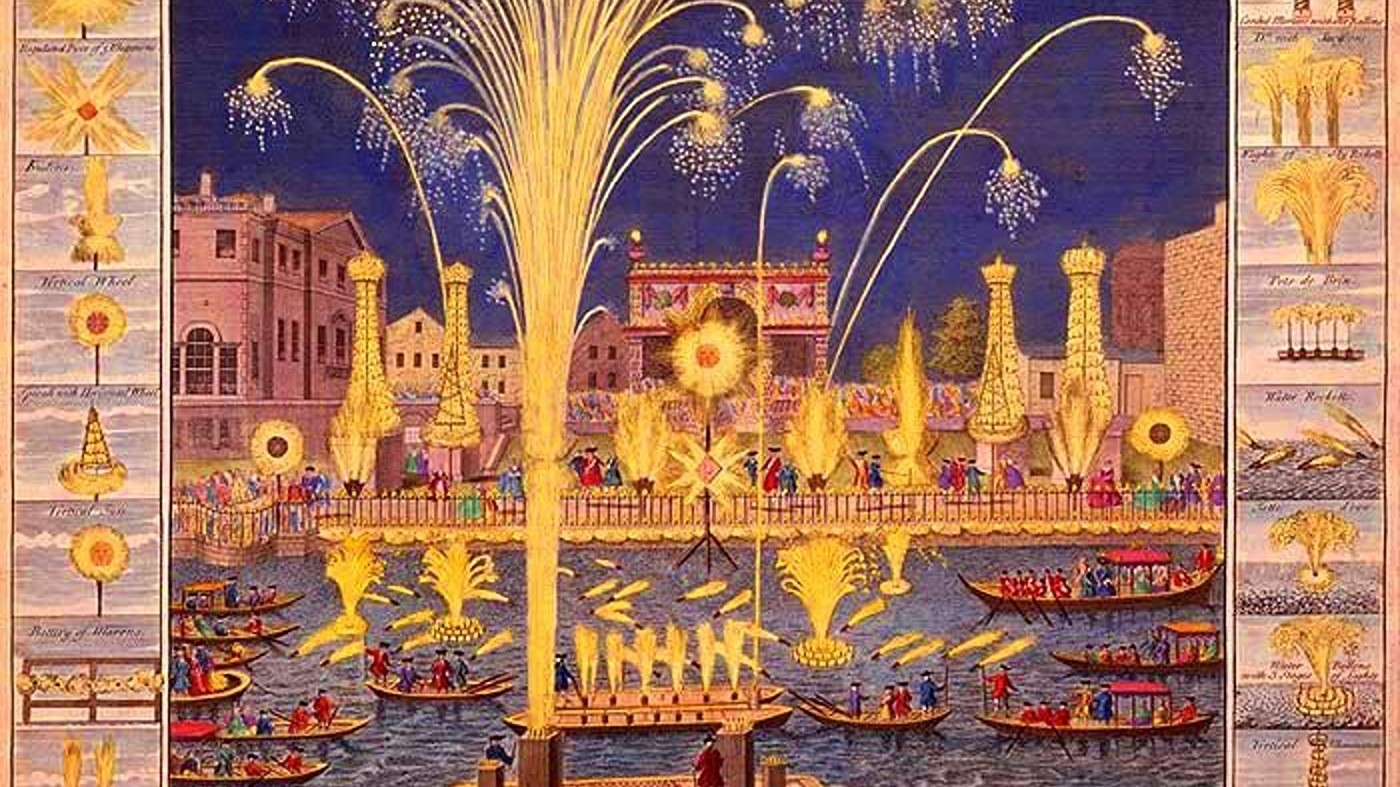On the afternoon of April 21, 1749, an estimated twelve thousand people, each paying two shillings and six pence, descended on London’s Vauxhall Gardens to take in an open-air rehearsal of Handel’s Music for the Royal Fireworks. The ensuing traffic jam resulted in a three-hour backup of carriages across London Bridge, and incidences of road rage.
Handel was commissioned to write the festive five-movement suite for a lavish public celebration which occurred a week later. The event commemorated the Treaty of Aix-la-Chapelle, ratified the previous year, which ended the War of Austrian Succession.
The plans for the party reached a grand scale. A massive pavilion, known as the “Machine,” was designed by the architect, Florentine Servandoni, and erected in Green Park, across from Buckingham Palace. A 100 canon salute would be followed by a massive fireworks display. The Music for the Royal Fireworks was scored for an enormous military wind band consisting of 24 oboes, 12 bassoons, contrabassoon, nine trumpets, nine horns, timpani, and side drums, which were directed to play ad libitum. To the composer’s dismay, the Duke of Montagu made it clear that King George II hoped that there would be “no fiddles.” Handel restored the string parts and reduced the winds for a subsequent performance a month later at Foundling Hospital.
The fireworks display, which took place on the evening of April 27, 1794, turned into a fiasco. Many of the fireworks failed to ignite. By one account, they “lighted so slowly that scarce anybody had patience to wait for the finishing.” Halfway through the evening, the “Machine” pavilion caught on fire and burned to the ground, causing panicked spectators to flee. An enraged Servandoni drew his sword on the Comptroller of the Fireworks, and was arrested. The statesman and man of letters, Horace Walpole, wrote that the display “by no means answered the expense, the length of preparation, and the expectation that had been raised.”
Yet Handel’s music endures. Filled with bright, irresistible melodies and a jubilant sense of rhythm, it is some of the most exulted and celebratory music ever conceived. As a child, I listened to this piece repeatedly, delighting in its directness, unabashed sense of spirit, and thrilling motion.
The Overture begins with a stately Adagio, punctuated by regal dotted rhythms. Its opening bars emphatically establish the triumphant key of D major, and, when the melody returns, it includes subtle new flourishes and harmonization. Instrumental “choirs” engage in a majestic “call and response.” (Horns and trumpets are set against reeds and strings). Unlike the French Overture, which the music resembles, the Allegro section which follows does not contain a fugue. Instead, it features a joyful instrumental conversation in which trumpet and horn fanfares ring out. Vigorous running lines in the strings and the trumpets’ soaring upward ascent bring to mind the euphoric energy of the Hallelujah Chorus from Handel’s Messiah.
The second and third movements are Baroque dances. First comes a light, cheerful Bourrée. This is followed by the La Paix – Largo alla Siciliana. The siciliano is a slow pastoral dance in a lilting 12/8 time. Bearing the title, “Peace,” Handel’s noble melody is serene, yet expansive, with successive phrases reaching ever higher.
Celebratory trumpets and drums return with the exuberant La Réjouissance. Two minuets bring the suite to a conclusion. The first moves into a sensuous D minor, concluding with oboes and bassoons. The second minuet is majestic and stirring. It is part grand courtly dance, part victory procession.
This 2023 performance, played on period instruments, features The English Concert, directed by Harry Bicket:
Five Great Recordings
- Handel: Music for the Royal Fireworks (original version), Trevor Pinnock, The English Concert Amazon
- Alfredo Bernardini and Zefiro
- Jeanne Lamon and Tafelmusik Baroque Orchestra
- Hervé Niquet and Le Concert Spirituel
- Rafael Kubelík and the Berlin Philharmonic
Featured Image: an artist’s depiction of the Royal Fireworks, 1749


I grew up on a recording of Handel’s Water Music and Royal Fireworks arranged for full modern orchestra by George Szell, on London/Decca records, with him conducting the London Symphony Orchestra. That particular recording-arrangement was seared into my brain as a kid and remains to this day my favorite version of these two classic works. I have to say the large modern orchestra better fits the intended grandeur of the event described above by Timothy than the more hallow-sounding period instruments.